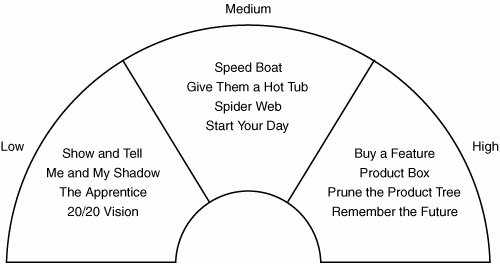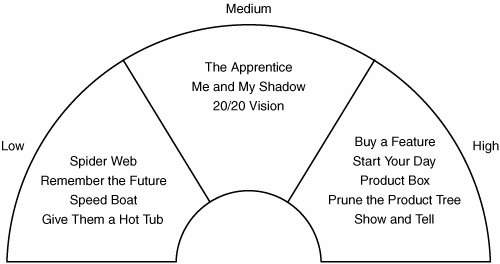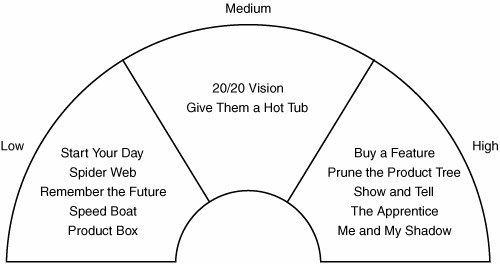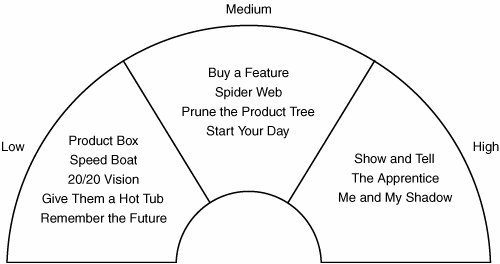Planning Your Innovation Game
Selecting the Right Innovation GameAs you become comfortable with playing Innovation Games, you'll find that it is rather easy to start with a high-level goal and then select the game that will help you best accomplish this goal. For example, suppose that you'd like to involve your customers in creating your product road map. Using Table 1.2 and the cards in the back of the book, you've narrowed down your choice to Buy a Feature and Prune the Product Tree. In fact, they both sound so good that you'd like to play them both, but you don't have enough time for this. You have to pick one. To help you make your choice, this section characterizes the various games along several key dimensions. Be careful about making your choice solely on reading this section, however, because each of the games can be tailored. The detailed descriptions of the games in Part Two will help you make your final choice, along with showing you how you can tailor the games to meet your circumstances. Here are the six dimensions that this section explores:
To help reinforce the idea that these are somewhat loose characterizations, the games are drawn in gauge format. These gauges will be repeated with each innovation game in Part Two for easy reference. Degree of Open-Ended ExplorationThe degree of open-ended exploration refers to how muchor how littleyou constrain interaction with a customer (see Figure 1.12). For example, Buy a Feature is one of the more constrained games because customers are working together to purchase the features that you've already priced. In contrast, Speed Boat and Product Box are both very unconstrained. In Speed Boat, customers can (and do!) write down just about anything on an anchor card. In Product Box, you're giving the customer a blank box and literally asking them to draw whatever they'd like. These unconstrained interactions tend to produce very open-ended explorations. Figure 1.12. Degree of Open-Ended Exploration Many games enable you to vary the degree of exploration. For example, you can make Me and My Shadow more open ended by shadowing customers as they perform general tasks, both with and without your products and services. Alternatively, you can constrain Me and My Shadow to focus primarily or solely on a predefined set of tasks or just your products and services. Let the questions that are motivating your use of the games inform the degree of open-ended exploration you'll bring to the game. Number of Customers Who Can Play the GameInnovation Games are designed for relatively small groups, typically between 4 and 24 people. However, we have had success in scaling some of the games to several hundred people. (See Figure 1.13.) The two key tricks in scaling the games to large groups is leveraging the natural structure of the games to subdivide larger groups into smaller groups that can play the games and changing the degree of facilitation within the games. Figure 1.13. Degree of Scalability
There is a limit to this process, however, no matter what game you're playing. For example, 20/20 Vision is a game that works best with a facilitator managing the discussion between 6 to 12 customers. If you want more customers to participate, you're going to need more facilitators, which naturally limits the degree of scalability. Also, keep in mind that larger groups produce more results, increasing both the complexity and time required to effectively post process these results into an agreed upon plan of action. Preparation WorkloadThere are three dimensions of preparation work for an Innovation Game: physical/materials preparation, market preparation, and customer preparation. Degree of Physical PreparationThe degree of physical preparation addresses the various supplies or materials that you need to play a game (see Figure 1.14). Games such as Remember the Future or 20/20 Vision, which require nothing more than standard flip charts or 5"x8" index cards, have a low degree of physical preparation, whereas others, such as Product Box, which requires a relatively large set of office supplies, have higher physical preparation requirements. Figure 1.14. Degree of Physical Preparation Degree of Market PreparationThe degree of market preparation concerns how much effort you have to put into preparing the content for the game (see Figure 1.15). Product Box ranks quite low in this dimension, because in Product Box you're not asking your customers to respond to your ideas. In contrast, 20/20 Vision ranks higher because you have to take the time to prepare the items (content) you want your customers to prioritize. Keep in mind that games that require more market preparation often help product teams make valuable choiceseven before playing the games with their customers! Figure 1.15. Degree of Market Preparation Degree of Customer PreparationThe degree of customer preparation concerns how much effort your customers will have to put into preparing to play the game. Both Product Box and 20/20 Vision rank low in this regard because in these games you're looking for the real-time reactions of customers during the game. In contrast, Show and Tell ranks much higher because you're explicitly asking customers to tell you about how they use your products and services. (See Figure 1.16.) Your customers who will be participating in the game will need time to prepare for this. Figure 1.16. Degree of Customer Preparation Time Frame of ActionThe games also vary by the time frame for putting the result of the game into action. Classifying time frames is very challenging because product cycle times differ so much by industries. Instead of giving you absolutes, I'll instead classify the time frame for action in terms of cycle times, with the understanding that each of the games has the potential to produce results that can span a wide range of times for action. (See Figure 1.17.) Figure 1.17. Time Frame of Action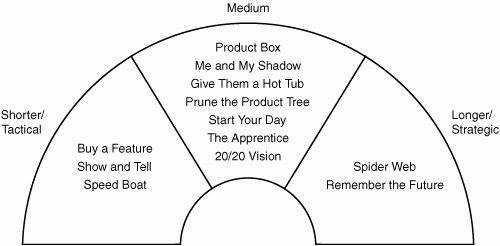
Keep in mind that a combination of factors helps regulate customers' expectations about the time frame of action. If you're playing Buy a Feature, it is typically because you want feedback about the next one or two product releases. Similarly, if you're playing Remember the Future, in which the future is 10 years from now, customers will readily expect that the time frame of action will be longer. Many customers, especially in business and professional markets, have a reasonable sense of the time frame associated with a suggested or requested action. They may even expect that something will take a longer time to accomplish based on their own strategic and tactical planning cycles. Keep in mind that you can always check your understanding of how quickly your customers expect you to act: just ask them.
|
EAN: 2147483647
Pages: 144

